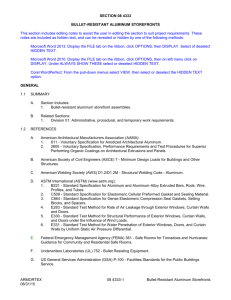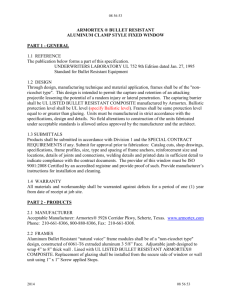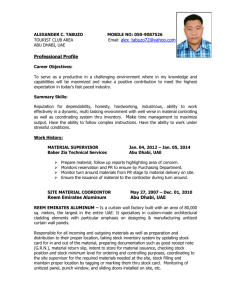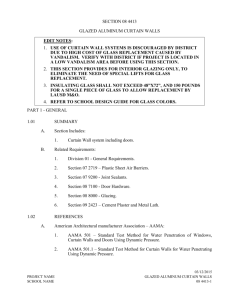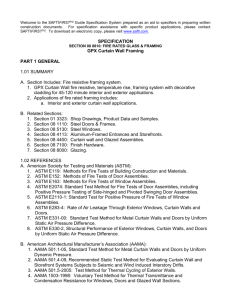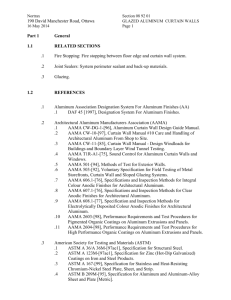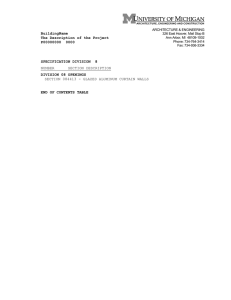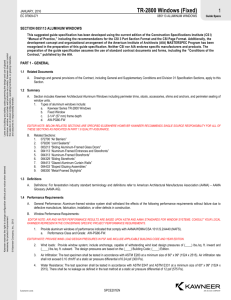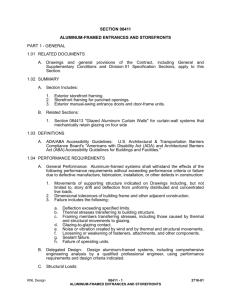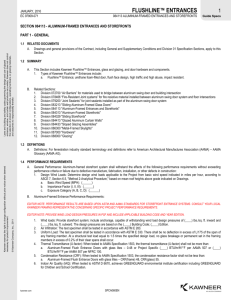Kynar Paint - Architectural Glass and Metal
advertisement
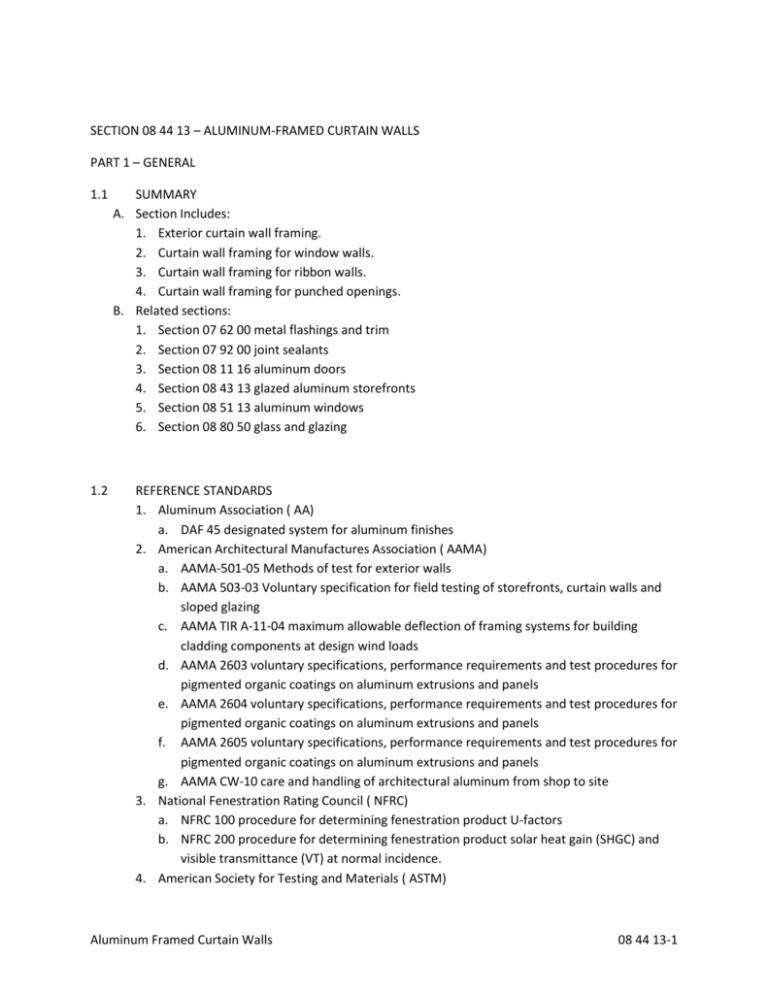
SECTION 08 44 13 – ALUMINUM-FRAMED CURTAIN WALLS PART 1 – GENERAL 1.1 1.2 SUMMARY A. Section Includes: 1. Exterior curtain wall framing. 2. Curtain wall framing for window walls. 3. Curtain wall framing for ribbon walls. 4. Curtain wall framing for punched openings. B. Related sections: 1. Section 07 62 00 metal flashings and trim 2. Section 07 92 00 joint sealants 3. Section 08 11 16 aluminum doors 4. Section 08 43 13 glazed aluminum storefronts 5. Section 08 51 13 aluminum windows 6. Section 08 80 50 glass and glazing REFERENCE STANDARDS 1. Aluminum Association ( AA) a. DAF 45 designated system for aluminum finishes 2. American Architectural Manufactures Association ( AAMA) a. AAMA-501-05 Methods of test for exterior walls b. AAMA 503-03 Voluntary specification for field testing of storefronts, curtain walls and sloped glazing c. AAMA TIR A-11-04 maximum allowable deflection of framing systems for building cladding components at design wind loads d. AAMA 2603 voluntary specifications, performance requirements and test procedures for pigmented organic coatings on aluminum extrusions and panels e. AAMA 2604 voluntary specifications, performance requirements and test procedures for pigmented organic coatings on aluminum extrusions and panels f. AAMA 2605 voluntary specifications, performance requirements and test procedures for pigmented organic coatings on aluminum extrusions and panels g. AAMA CW-10 care and handling of architectural aluminum from shop to site 3. National Fenestration Rating Council ( NFRC) a. NFRC 100 procedure for determining fenestration product U-factors b. NFRC 200 procedure for determining fenestration product solar heat gain (SHGC) and visible transmittance (VT) at normal incidence. 4. American Society for Testing and Materials ( ASTM) Aluminum Framed Curtain Walls 08 44 13-1 a. ASTM B 221-08 specification for aluminum-alloy extruded bars, rods, wire, profiles and tubes b. ASTM E 283 standard test method for determining rate of air leakage through exterior windows, curtain walls, and doors under specified pressure differences across the specimen. c. ASTM E 330 standard test method for structural performance of exterior windows, doors, skylights and curtain walls by uniform static air pressure difference d. ASTM E 331 standard test method for water penetration of exterior windows, skylights, doors, and curtain walls by uniform static air pressure difference 1.3 A. B. C. D. PERFORMANCE REQUIREMENTS General Performance: Aluminum-framed systems shall withstand the effects of the following performance requirements without exceeding performance criteria or failure due to defective manufacture, fabrication, installation, or other defects in construction: 1. Movements of supporting structure indicated on Drawings including, but not limited to, story drift and deflection from uniformly distributed and concentrated live loads. 2. Dimensional tolerances of building frame and other adjacent construction. 3. Failure includes the following: a. Defection exceeding specified limits. b. Thermal stresses transferring to building structure. c. Framing members transferring stresses, including those caused by thermal and structural movements to glazing. d. Noise or vibration created by wind and by thermal and structural movements. e. Loosening or weakening of fasteners, attachments, and other components. f. Failure of operating units. Delegated Design: Design aluminum-framed systems, including comprehensive engineering analysis by a qualified professional engineer, using performance requirements and design criteria indicated. Wind Loads: 70 M.P.H. exposure B, importance factor 1. Deflection of Framing Members: 1. Deflection Normal to Wall Plane: Limited to edge of glass in a direction perpendicular to glass plane shall not exceed L/175 of clear span for spans up to 13 feet 6 inches (4.1m) and to L/240 of clear span plus ¼ inch (6.35 mm) for spans greater than 13 feet 6 inches (4.1 m or an amount that restricts edge deflection of individual glazing lites to ¾ inch (19mm), whichever is less. 2. Deflection Parallel to Glazing Plane: Limited to L/360 of clear span or 1/8 inch (3.2 mm), whichever is smaller, amount not exceeding that which reduces glazing bite to less than 75 percent of design dimension and that which reduces edge clearance between framing members and glazing or other fixed components directly below them to less than 1/8 inch (3.2 mm) and clearance between members and operable units directly below them to less than 1/16 inch (1.5 mm) Aluminum Framed Curtain Walls 08 44 13-2 E. Structural-Test Performance: Provide aluminum-framed systems tested according to ASTM E 330 as follows: 1. When tested to design pressure comply with 1.3.D.1 2. When tested at 150 percent of positive and negative wind-load design pressures, systems, including anchorage, do not evidence material failures, structural distress, and permanent deformation of main framing members exceeding 0.2 percent of span. 3. Test Durations: 10 seconds. F. Air Infiltration: Provide aluminum-framed systems with maximum air leakage through fixed glazing and framing areas of 0.06 cfm/sq. ft. ( 0.03 L/s per sq. m) of fixed wall area when tested according to ASTM E 283 at a minimum static-air-pressure difference of 1.57 lbf/sq. ft. (75 Pa) G. Water Penetration under Static Pressure: Provide aluminum-framed systems that do not evidence water penetration through fixed glazing and framing areas when tested according to ASTM E 331 at a minimum static-air-pressure difference of 20 percent of positive wind-load design pressure, but not less than 15.0 lbf/sq. ft. ( 720 Pa) H. Water Penetration under Dynamic Pressure: Provide aluminum-framed systems that do not evidence water penetration through fixed glazing and framing areas when tested according to AAMA 501.1 05 at a minimum static-air-pressure difference of 20 percent of positive wind-load design pressure, but not less than 15.0 lbf/sq. ft. ( 720 Pa) 1.4 SUBMITTALS A. Product Data: For each type of product indicated. B. Qualification Data: For installer C. LEED Submittal: 1. Product Data for EA, MR, and IEQ Credits. D. Shop Drawing: For aluminum-framed systems. Include plans, elevations, sections, details, and attachments to other work. 1. Include details of provisions for system expansion and contraction and for drainage of moisture in the system to the exterior. E. Samples: For each type of exposed finish required. 1. 12 inches long for extrusions 2. 12 inches x 12 inches for sheet products F. Other Action Submittals: 1. Entrance Door Hardware Schedule: Prepared by or under the supervision of supplier, detailing fabrication and assembly of entrance door hardware, as well as procedures and diagrams. G. Delegated-Design Submittal: For aluminum-framed systems indicated to comply with performance requirements and design criteria, including analysis data signed and sealed by the qualified professional engineer responsible for their preparation. H. Product test reports. I. Sample of field quality-control report format. Aluminum Framed Curtain Walls 08 44 13-3 J. Maintenance data. K. Warranties: Sample of special warranties. L. Evidence of ability to provide products that meet the energy requirements of the ENV1/COMcheck form. 1.5 QUALITY ASSURANCE A. Installer Qualifications: Installers detailed information that shows competency to perform the work of this section 1. List projects completed that have same or similar products used on this project. B. Testing Agency Qualifications: Qualified according to ASTM E 699 for testing indicated. C. Engineering Responsibility: Prepare data for aluminum-framed systems, including Shop Drawings, based on testing and engineering analysis of manufacturer’s units in systems similar to those indicated for this Project. D. Product Options: Information on Drawings and in Specifications establishes requirements for systems’ aesthetic effects and performance characteristics. Aesthetic effects are indicated by dimensions arrangements, alignment, and profiles of components and assemblies as they relate to sightlines, to one another, and to adjoining construction. Performance characteristics are indicated by criteria subject to verification by one or more methods including preconstruction testing, field testing, and in-service performance. E. Source Limitations for Aluminum-Framed Systems: Obtain from single source from single manufacturer. F. Pre-installation Conference: attend a pre-installation conference at a site to be determined. 1.6 WARRANTY A. Special Warranty: Installation contractors warrantee in which installation contractor agrees to repair or replace components on which finishes do not comply with requirements or that fail in materials or workmanship within specified warranty period. The installation contractor may supplement his warranty with a pass through warrantee of the systems manufacturer. 1. Warranty Period: One year from date of Substantial Completion. B. Special Finish Warranty: Installation contractors warrantee in which installation contractor agrees to repair or replace components on which finishes do not comply with requirements or that fail in materials or workmanship within specified warranty period. Warranty does not include normal weathering. The installation contractor may supplement his warranty with a pass through warrantee of the systems manufacturer. 1. Warranty Period: Five years from date of Substantial Completion. PART 2 – PRODUCTS 2.1 MANUFACTURERS A. Manufacturers: Subject to compliance with requirements, provide products by one of the following: Aluminum Framed Curtain Walls 08 44 13-4 B. Basis-of-Design Product: Subject to compliance with requirements, is the PRL ALUMINUM CW600/700 series 2 ½” x 6” and 7” front set glazing or comparable product by one of the following: 1. Walters and Wolf 2. AGA, Architectural Glass and Aluminum 3. Tubelite Inc. 4. Wausau Window and Wall system C. Requests for substitution of other manufactures must be made 15 days prior to bid date. Substitution requests must include: 1. Test reports showing compliance with performance section 2. ½ scale drawings showing profiles are comparable with basis of design product 3. Comparative analysis showing the performance characteristics Vs basis of design 4. Physical samples of proposed substitution. 2.2 MATERIALS A. Aluminum: Alloy and temper recommended by manufacturer for type of use and finish indicated. 1. Sheet and Plate: ASTM B 209 (ASTM B 209M). 2. Extruded Bars, Rods, Profiles, and Tubes: ASTM B 221 (ASTM B 221M). 3. Extruded Structural Pipe and Tubes: ASTM B 429. 4. Structural Profiles: ASTM B 308/B 308M. 5. Welding rods and Bare Electrodes: AWS A5.10/A5.10M B. Steel Reinforcement: Manufacturer’s standard zinc-rich, corrosion-resistant primer, complying with SSPC-PS Guide No. 12.00; applied immediately after surface preparation and pretreatment. Select surface preparation methods according to recommendations in SSPC-SP COM and prepare surfaces according to applicable SSPC standards. 1. Structural Shapes, Plates and Bars: ASTM A 36/A 36M. 2. Cold-Rolled Sheet and Strip: ASTM A 1008/A 1008M. 3. Hot-Rolled Sheet and Strip: ASTM A 1011/A 1011M. 2.3 FRAMING SYSTEMS A. Framing Members: Manufacturer’s standard extruded-aluminum framing members of thickness required and reinforced as required to support imposed loads. 1. Construction: thermal improved. 2. Glazing System: Retained mechanically with gaskets on four sides or structurally adhered glazing using high performance silicone adhesives designed specifically for this purpose. 3. Glazing Plane: Front. B. Brackets and Reinforcements: Manufacturer’s standard high-strength aluminum with nonstaining, nonferrous shims for aligning system components. C. Fasteners and Accessories: Manufacturer’s standard corrosion-resistant, non-staining, nonbleeding fasteners and accessories compatible with adjacent materials. Aluminum Framed Curtain Walls 08 44 13-5 1. Use self-locking devices where fasteners are subject to loosening or tuning out from thermal and structural movements, wind loads, or vibration. 2. Reinforce members as required to receive fastener threads. 3. Use exposed fasteners with countersunk Phillips screw heads fabricated from stainless steel. D. Concrete and Masonry Inserts: Hot-dip galvanized cast-iron, malleable-iron, or steel inserts, complying with ASTM A 123/A 123M or ASTM A 153/A153M. E. Concealed Flashing: Manufacturer’s standard corrosion-resistant, non-staining, non-bleeding flashing compatible with adjacent materials or Dead-soft, 0.018-inch- (0.457-mm-)thick stainless steel, ASTM A 240/A 240M of type recommended by manufacturer. F. Framing System Gaskets and Sealants: Manufacturer’s standard, recommended by manufacturer for joint type. 1. Provide sealants for use inside of the weatherproofing system that have a VOC content of 250 g/L or less when calculated according to 40 CFR 59, Subpart D (EPA Method 24) 2.4 GLAZING SYSTEMS A. Glazing: As specified in Division 8 Section “Glazing”. B. Glazing Gaskets: Manufacturer’s standard compression types; replaceable, molded or extruded, of profile and hardness required to maintain watertight seal. PVC gaskets are not acceptable. C. Spacers and Setting Blocks: Manufacturer’s standard elastomeric type. 2.5 ACCESSORY MATERIALS A. Bituminous Paint: Cold-applied, asphalt-mastic paint complying with SSPC-Paint 12 requirements except containing no asbestos; formulated for 30-mil (0.762-mm) thickness per coat. 2.6 FABRICTION A. Form or extrude aluminum shapes before finishing. B. Weld in concealed locations to greatest extent possible to minimize distortion or discoloration of finish. Remove weld spatter and welding oxides from exposed surfaces by de-scaling or grinding. C. Framing Members, General: Fabricate components that, when assembled, have the following characteristics: 1. Profiles that are sharp, straight, and free of defects or deformations. 2. Accurately fitted joints with ends coped or mitered. 3. Means to drain water passing joints, condensation within framing members, and moisture migrating within the system to exterior. 4. Physical and thermal isolation of glazing from framing members. 5. Accommodations for thermal and mechanical movements of glazing and framing to maintain required glazing edge clearances. 6. Provisions for field replacement of glazing from exterior. Aluminum Framed Curtain Walls 08 44 13-6 7. Fasteners, anchors, and connection devices that are concealed from view to greatest extent possible. D. Mechanically Glazed Framing Members: Fabricate for flush glazing without projecting stops. E. Entrance Door Frames: Reinforce as required to support loads imposed by door operation and for installing entrance door hardware. 2.7 ALUMINUM FINISHES A. General: Comply with NAAMM’s “metal finishes manual for architectural and metal products” for recommendations B. High-Performance Organic Finish: 2-coat fluoropolymer finish complying with [AAMA 2604] [AAMA 2605] and containing not less than [50] [70] percent PVDF resin by weight in color coat. 1. Color and Gloss: [As indicated by manufacturer’s designations] [Match Architect’s sample] [As selected by Architect from manufacturer’s full range] <Insert color and gloss>. PART 3 – EXECUTION 3.1 INSTALLATION A. General: 1. Comply with manufacturer’s written instructions. 2. Do not install damaged components. 3. Fit joints to produce hairline joints free of burrs and distortion. 4. Rigidly secure non-movement joints. 5. Install anchors with separators and isolators to prevent metal corrosion and electrolytic deterioration. 6. Seal joints watertight unless otherwise indicated. B. Metal Protection: 1. Where aluminum will contact dissimilar metals, protect against galvanic action by painting contact surfaces with primer or applying sealant or tape, or by installing nonconductive spacers as recommended by manufacturer for this purpose. 2. Where aluminum will contact concrete or masonry, protect against corrosion by painting contact surface with bituminous paint. C. Install components to drain water passing joints, condensation occurring within framing members, and moisture migrating within the system to exterior. D. Set continuous sill members and flashing in full sealant bed as specified in Division 7 Section “Joint Sealants” to produce weather tight installation. E. Install components plumb and true in alignment with established lines and grades, and without warp or rack. F. Install glazing as specified in Division 8 Section “Glazing.” G. Entrance Doors: Install doors to produce smooth operation and tight fit at contact points. 1. Exterior Doors: Install to produce weather tight enclosure and tight fit at weather stripping. Aluminum Framed Curtain Walls 08 44 13-7 2. Field- Installed Entrance Door Hardware: Install surface-mounted entrance door hardware according to entrance door hardware manufacturers’ written instructions using concealed fasteners to greatest extent possible. 3.2 FIELD QUALITY CONTROL A. Testing Agency: The owner may at his discretion employ a qualified independent testing and inspecting agency to perform field tests and inspections. B. Testing Services: Testing and inspecting of representative areas to determine compliance of installed systems with specified requirements shall take place as follows. Do not proceed with installation of the next area until test results for previously completed areas show compliance with requirements. 1. Water Spray Test: Before installation of interior finishes has begun, areas designated by Architect shall be tested according to AAMA 501.2 and shall not evidence water penetration. C. Repair or remove work if test results and inspections indicate that it does not comply with specified requirements. D. Additional testing and inspecting on portions of the work that are found to be non compliant will be at Contractor’s expense and will be performed to determine compliance of replaced or additional work with specified requirements. E. Aluminum-framed assemblies will be considered defective if they do not pass tests and inspections. F. Prepare test and inspection reports. END OF SECTION 08411 Aluminum Framed Curtain Walls 08 44 13-8
